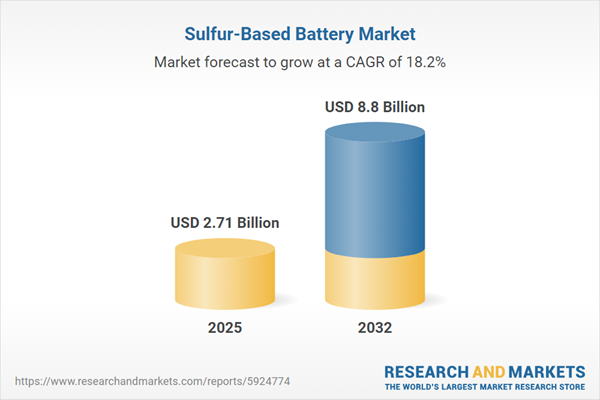Speak directly to the analyst to clarify any post sales queries you may have.
Sulfur-based battery technology is gaining traction among senior executives seeking innovative energy solutions. As global industries confront evolving energy challenges, enterprises are steadily adopting sulfur-based batteries to enhance long-term reliability, manage procurement risks, and support sustainability objectives.
Sulfur-Based Battery Market Snapshot
The sulfur-based battery market is valued at USD 2.31 billion in 2024, quickly advancing on strong enterprise investment and technological innovation. With robust growth projections and an anticipated compound annual rate of 18.18% through 2032, market participants are investing to capture rising demand. This momentum reflects organizations accelerating integration of sulfur-based battery systems to meet evolving regulatory requirements and modern business models. Key drivers include organizational goals for higher energy density, enhanced operational stability, and reduction of long-term costs. As the marketplace continues to mature, sulfur-based batteries are becoming essential to organizations prioritizing energy security and proactive sustainability management.
Sulfur-Based Battery Market: Scope & Segmentation
- Battery Types: Lithium-Sulfur solutions are favored in aerospace and weight-sensitive fields, delivering higher gravimetric energy. Magnesium-Sulfur and Sodium-Sulfur alternatives offer adaptable deployment options for applications ranging from mobile electronics to energy storage infrastructure, addressing concerns tied to critical mineral sourcing.
- Power Capacity Segments: Sub-500mAh batteries target compact and portable devices, aiding efficiency in smaller electronics. The 501–1,000mAh category suits moderate industrial and equipment needs. Large-capacity models, exceeding 1,000mAh, are optimized for infrastructure-scale applications, allowing enterprises to address variable demand profiles across utility and manufacturing sectors.
- End-Use Industry: Deployment spans consumer electronics, finance, automotive, aerospace, and utilities. System efficiency gains, robust safety measures, and performance reliability are prioritized, especially by transport and financial industries seeking resilience against demand uncertainty.
- Target Market: Commercial, industrial, and residential segments all benefit from sulfur-based battery technologies, leveraging standalone, modular, or networked arrangements to optimize distributed or centralized energy management.
- Regional Coverage: The Americas, Europe, Middle East & Africa, and Asia-Pacific are advancing adoption. Market dynamics are shaped by policy initiatives, investment activity, and sector leadership in countries such as the United States, China, Germany, India, Japan, the UK, and South Korea, reflecting diverse regulatory and innovation ecosystems.
- Companies Profiled: Prominent providers include BASF SE, Toyota Motor Corporation, The Mercedes-Benz Group AG, GS Yuasa Corporation, LG Energy Solution Ltd., Stellantis NV, and Saft Groupe SAS by TotalEnergies SE. These enterprises drive portfolio growth, secure strategic supply chains, and influence international market standards.
Sulfur-Based Battery Market: Key Takeaways for Decision-Makers
- Material versatility reduces exposure to critical mineral dependencies, reinforcing supply chain continuity and agile procurement planning across complex operational environments.
- Technological progress in core components such as electrodes and electrolytes enhances battery adaptability, expanding deployment opportunities across diverse industry sectors and new use cases.
- Life cycle management strategies are emphasizing the circular economy, focusing on retrofitting and improved resource recovery to support sustainable growth and extend asset value for enterprises.
- Localized manufacturing and dedicated recycling investments minimize risk from international disruptions, aided by supportive regulations and tailored industry incentives.
- Growth in mobility, aerospace, and utility applications is foundational to driving renewable integration and strengthening distributed grid capabilities, assisting large facilities to handle variable load requirements.
Tariff Impact on Supply Chain Dynamics
Recent policy changes and tariffs impacting battery-grade materials in the United States are prompting manufacturers to revisit supply chain models. Enterprise responses include shifting toward vertical integration, intensifying research alliances, and adopting adaptive sourcing approaches. These measures are designed to uphold resilience and competitiveness in changing global conditions, ensuring supply chain agility and robust risk mitigation.
Methodology & Data Sources
This market analysis combines insights from expert interviews, industry-wide surveys, benchmarking, and direct feedback from end users. Comprehensive policy and regulatory assessments reinforce the accuracy and applicability of findings, equipping executive stakeholders with actionable intelligence for strategic decision-making.
Why This Report Matters
- Enables executives to anticipate and address regulatory changes, positioning their organizations to remain compliant and agile in the sulfur-based battery sector.
- Provides actionable recommendations for managing risks related to supply chain disruptions and tariffs, guiding investments in sourcing and partnerships for long-term stability.
- Ensures alignment of energy procurement and sustainability goals with leading market and regulatory practices across global operational regions.
Conclusion
Sulfur-based battery technology offers a compelling path to greater energy resilience and sustainable operations. Remaining attuned to regulatory and technological developments is essential for steering enterprises toward confident leadership through ongoing energy transitions.
Additional Product Information:
- Purchase of this report includes 1 year online access with quarterly updates.
- This report can be updated on request. Please contact our Customer Experience team using the Ask a Question widget on our website.
Table of Contents
3. Executive Summary
4. Market Overview
7. Cumulative Impact of Artificial Intelligence 2025
Companies Mentioned
The companies profiled in this Sulfur-Based Battery market report include:- BASF SE
- BioLargo, Inc.
- Gelion PLC
- Giner Inc.
- Graphene Batteries AS
- GS Yuasa Corporation
- Hybrid Kinetic Group Ltd.
- Idemitsu Kosan Co.,Ltd
- Iolitec Ionic Liquids Technologies GmbH
- LG Energy Solution Ltd.
- Li-S Energy Limited
- Lyten, Inc.
- Navitas System, LLC Corporate
- NEI Corporation
- NexTech Batteries Inc.
- NGK Insulators, Ltd.
- PolyPlus Battery Company
- Rechargion Energy Private Limited
- Robert Bosch GmbH
- Saft Groupe SAS by TotalEnergies SE
- Sion Power Corporation
- Sionic Energy
- Solid Power, Inc.
- Steatite Limited by Solid State PLC
- Stellantis NV
- The Mercedes-Benz Group AG
- Theion GmbH
- Toyota Motor Corporation
- VTC Power Co.,Ltd
- Zeta Energy Corporation
Table Information
| Report Attribute | Details |
|---|---|
| No. of Pages | 180 |
| Published | November 2025 |
| Forecast Period | 2025 - 2032 |
| Estimated Market Value ( USD | $ 2.71 Billion |
| Forecasted Market Value ( USD | $ 8.8 Billion |
| Compound Annual Growth Rate | 18.1% |
| Regions Covered | Global |
| No. of Companies Mentioned | 31 |









